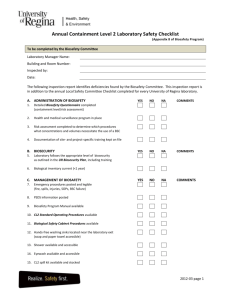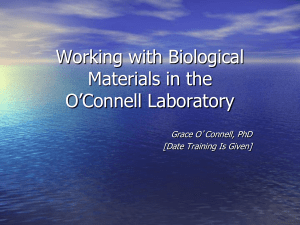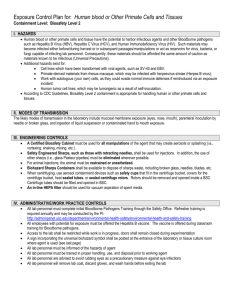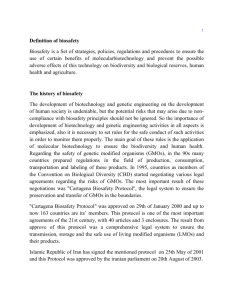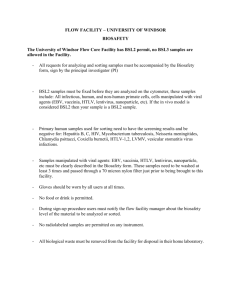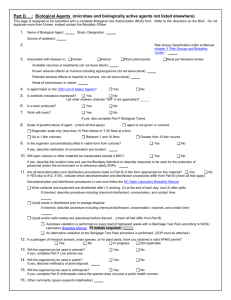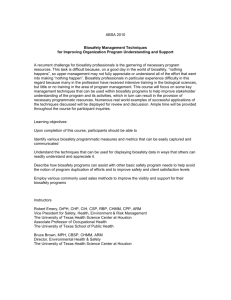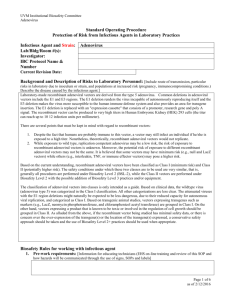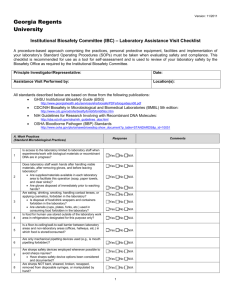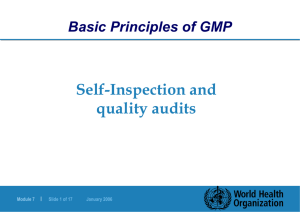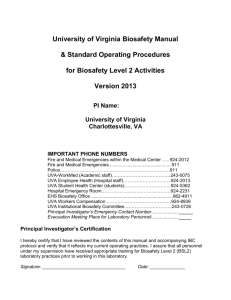Biological Self-Inspection Checklist
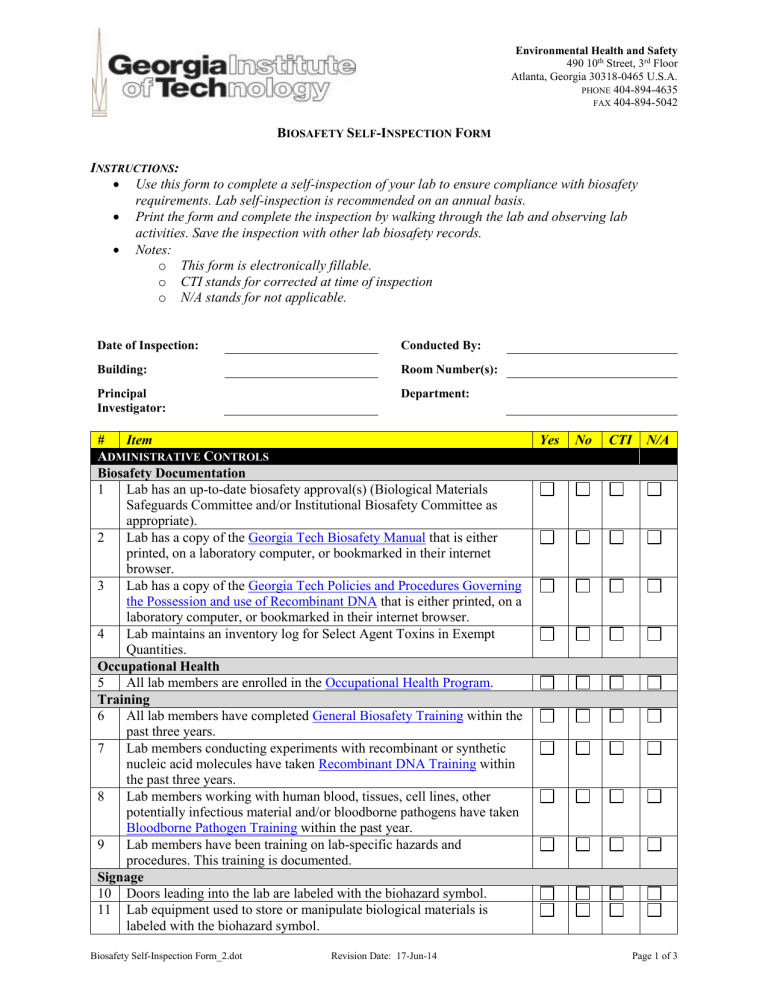
Environmental Health and Safety
490 10 th Street, 3 rd Floor
Atlanta, Georgia 30318-0465 U.S.A.
PHONE 404-894-4635
FAX 404-894-5042
B
IOSAFETY
S
ELF
-I
NSPECTION
F
ORM
I NSTRUCTIONS :
Use this form to complete a self-inspection of your lab to ensure compliance with biosafety requirements. Lab self-inspection is recommended on an annual basis.
Print the form and complete the inspection by walking through the lab and observing lab activities. Save the inspection with other lab biosafety records.
Notes: o This form is electronically fillable. o CTI stands for corrected at time of inspection o N/A stands for not applicable.
Date of Inspection:
Building:
Conducted By:
Room Number(s):
Principal
Investigator:
Department:
# Item
A DMINISTRATIVE C ONTROLS
Biosafety Documentation
1 Lab has an up-to-date biosafety approval(s) (Biological Materials
Safeguards Committee and/or Institutional Biosafety Committee as appropriate).
2 Lab has a copy of the Georgia Tech Biosafety Manual that is either printed, on a laboratory computer, or bookmarked in their internet browser.
3 Lab has a copy of the Georgia Tech Policies and Procedures Governing the Possession and use of Recombinant DNA that is either printed, on a laboratory computer, or bookmarked in their internet browser.
4 Lab maintains an inventory log for Select Agent Toxins in Exempt
Quantities.
Occupational Health
5 All lab members are enrolled in the Occupational Health Program .
Training
6 All lab members have completed General Biosafety Training within the past three years.
7 Lab members conducting experiments with recombinant or synthetic nucleic acid molecules have taken Recombinant DNA Training within the past three years.
8 Lab members working with human blood, tissues, cell lines, other potentially infectious material and/or bloodborne pathogens have taken
Bloodborne Pathogen Training within the past year.
9 Lab members have been training on lab-specific hazards and procedures. This training is documented.
Signage
10 Doors leading into the lab are labeled with the biohazard symbol.
11 Lab equipment used to store or manipulate biological materials is labeled with the biohazard symbol.
Yes No CTI N/A
Biosafety Self-Inspection Form_2.dot Revision Date: 17-Jun-14 Page 1 of 3
B IOSAFETY S ELF -I NSPECTION F ORM
# Item
12 Lab freezers and refrigerators are labeled with “No Food or Drink
Allowed”.
13 The Pink Emergency Contact Card displays current emergency contact information and is posted in plain sight.
E NGINEERING C ONTROLS
Biosafety Cabinets (BSC)
14 BSCs have been certified in the past year by the Georgia Tech approved vendor and are functioning properly. The certification label is attached to the BSC.
15 BSCs that have failed certification or have not been certified within the past year are tagged out of service and are not in use.
16 Items are not stored on top of the BSC.
17 Bunsen burners and/or open flames are not used in the BSC. Flammable gas is not used or connected to BSC gas lines (i.e., natural gas).
18 BSC airflow and grills are free from obstructions.
19 The BSC sash is functioning properly, set at an appropriate height, not cracked, and the alarm is not muted.
Laminar Flow Hoods/Clean Benches
20 All active laminar flow hoods/clean benches have been certified within the past year by the Georgia Tech approved vendor and are functioning properly. The certification label is attached and initialed by the vendor.
21 Laminar flow hoods/clean benches are not used to work with biohazard or other hazardous material.
Centrifuges
22 Centrifuges have door interlocks (mechanism to keep lid closed during operation).
23 Secondary containment (i.e., centrifuge safety caps, buckets, sealed rotors) is available and used when centrifuging infectious samples.
Emergency Equipment
24 Lab is equipped with a double ocular eyewash.
25 Eyewashes tested weekly and the test is documented.
26 Eyewash protective caps are in place.
27 Lab is equipped with a safety shower.
28 Eyewashes and safety showers are free of obstruction for easy access during an emergency.
P ERSONAL P ROTECTIVE E QUIPMENT & L AB A TTIRE
29 Lab coats are worn while working in the lab.
30 Safety glasses or another type of face protection are worn at all times in the lab.
31 Gloves are worn while working in the lab.
32 Closed toed shoes and long pants/skirts are worn at all times in the lab.
33 Lab coats are laundered on a regular basis by an approved method.
34 Lab members do not wash or reuse disposable gloves.
35 Lab members remove gloves before leaving the lab.
36 Long hair is tied back while working in the lab.
W ASTE M ANAGEMENT
Sharps
37 Unprotected sharps are not left unattended, lying out on bench tops.
38 Disposable sharps are properly disposed of in hard walled sharps container and containers are no greater than ¾ full.
39 Sharps containers are labeled with the date of first sharp disposal and principal investigator name.
Yes No CTI N/A
Biosafety Self-Inspection Form_2.dot Revision Date: 17-Jun-14 Page 2 of 3
B IOSAFETY S ELF -I NSPECTION F ORM
# Item
40 Sharps containers are within allowable disposal dates: 30 days for infectious sharps and 6 months for non-infectious sharps.
41 Needles are not bent, sheared, broken, recapped, removed from disposable syringes, or otherwise manipulated by hand before disposal.
Solid Biological Waste
42 Animal carcasses are double bagged and refrigerated/frozen until pickup.
43 The final destination for solid biological waste is the Georgia Tech biological waste vendor.
Liquid Biological Waste
44 Biologically contaminated liquids are disinfected prior to disposal down the drain.
Broken Glass
45 Broken glass containers with plastic liners are available and no greater than ¾ full.
46 Lab disposes of non-contaminated broken glass in broken glass containers. Lab does not use broken glass containers for the disposal of sharps, biohazard-contaminated glass, gloves, used bulbs, etc.
E MERGENCY P REPAREDNESS
47 Lab is equipped with a biological spill kit. This includes bleach/appropriate disinfectant, absorbent material, and tongs/dustpan.
48 Lab members have been trained on how to clean up a biological spill.
49 Lab members know how to report accidents and injuries.
H OUSEKEEPING
50 Lab sinks are equipped with soap and paper towels for handwashing.
51 Lab floor is easily cleanable (i.e., no carpet or rugs) and can handle the anticipated loads.
52 Bench tops are smooth for easy cleaning.
53 Chairs are easily cleanable and not covered in porous fabric.
54 Lab is under restricted access (i.e., doors are lockable, doors are kept closed).
55 Mechanical pipetting devices are used.
56 Food/drinks/cosmetics/lotions are not present in the lab.
57 Work surfaces are cleaned and decontaminated with bleach or alcohol
(or an appropriate disinfectant) after each use and are visibly clean.
58 Bench papers are changed on a regular basis.
59 Materials transported outside of the lab are in a leak proof container marked with a biohazard symbol.
60 Lab benches are uncluttered to allow space for safe work practices.
C OMMENTS :
Yes No CTI N/A
Biosafety Self-Inspection Form_2.dot Revision Date: 17-Jun-14 Page 3 of 3
